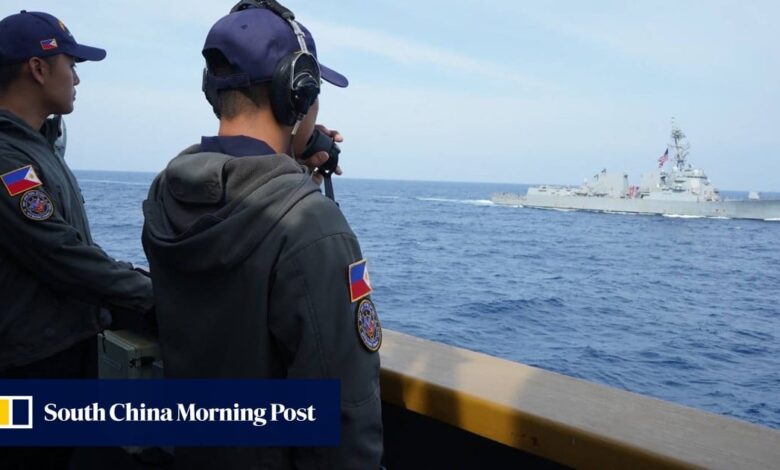US to help Philippines upgrade key defence bases amid rising South China Sea tensions

[ad_1]
“We are not just looking at how we can operate together more efficiently, but also we are looking at the future operations that we are going to conduct,” Brawner said. “All of these factors should come in as we decide on which projects we’re really going to pursue.”
The EDCA is a defence agreement signed between the US and the Philippines in 2014 that allows the US military to rotate troops into the Southeast Asian nation for extended stays and allows Washington to build and operate facilities for both US and Philippine forces.
“The Philippines is being pressured militarily by China and its past efforts to reach compromise positions with China have left it burned each time. Thus it is tilting toward the US and US allies to safeguard its own interests,” said John Bradford, executive director of Yokosuka Council on Asia-Pacific Studies.
“[Manila] has decided that in the face of continued Chinese aggression, hardening itself militarily is the best way to advance that deterrence.”
Manila says it has a ‘lot of evidence’ against China over alleged damaged corals
Manila says it has a ‘lot of evidence’ against China over alleged damaged corals
Beijing has opposed the expanded military deal between Washington and Manila. Huang Xilian, Chinese ambassador to the Philippines, said in April that Manila was “stoking the fire” over Taiwan’s independence.
In response, Marcos said during his visit to Washington in May the EDCA sites are not intended to be used for “any offensive action” against any other country, and such actions are outside the parameters of what Manila had discussed with the US.
Analysts said Camilo Osias and Lal-lo could play critical roles in the case of an armed conflict between mainland China and Taiwan, thanks to their strategic location.
“The locations of Camilo Osias Naval Base and Lal-lo Airport would enable them to provide important military functions in a Taiwan conflict,” Bradford said. “Forces operating from those bases would have immediate access to defending Taiwan’s southern flank and prevent China from breaking out into the Philippine Sea through the Bashi Channel.”
Aaron Jed Rabena, a research fellow at Asia-Pacific Pathways to Progress in Manila: “The Bashi Channel is a very strategic waterway for a state actor that intends to exercise greater sea control and sea power through the passage of its naval – surface and subsurface – assets.
“Therefore, a state actor who dominates this area could put other state actors at its mercy.

“This means that US military assets could operate closer to China and will make it easier for the US to preposition assets in the event of a contingency in nearby areas.”
Raymond Kuo, director of the Taiwan Policy Initiative at US-based think tank Rand Corporation, said Beijing will attempt to gain naval control over the Bashi Channel to limit external support coming from the Philippines in the case of a conflict over Taiwan.
“Chinese naval control of the Bashi Channel allows it to limit support coming from the south, as well as swing through relatively open water to set a picket on Taiwan’s eastern side,” Kuo said. “They would then be in a position to interdict US support from Guam and possibly complicate US and allied support coming from the north.
“Upgrading Camilo Osias and Lal-lo provides regional forces with hard points from which they can complicate these Chinese operations in turn.”
The Chinese navy has recently ramped up a large-scale naval exercise in the western Pacific Ocean through the Bashi Channel.
In April, PLA’s aircraft carrier Shandong passed through the waterway on its first voyage to the western Pacific, where it conducted anti-submarine, joint-fire strikes and regional air control exercises.
Tensions between Beijing and Manila have also intensified in the South China Sea. Last month, the Philippine Coast Guard said Chinese vessels had fired “illegal” and “dangerous” water cannons towards ships carrying supplies for Philippine military personnel stationed at Second Thomas Shoal in the disputed Spratly Islands.
Collin Koh, a senior fellow at the S Rajaratnam School of International Studies in Singapore, said while there is no unanimity in Manila over the country’s role should an armed conflict break out in the Taiwan Strait, the EDCA sites near the Bashi Channel are expected to help the Philippines secure its interests over the South China Sea.
“The South China Sea and Taiwan cannot be so easily delinked from each other … In the event of a Taiwan conflict, the South China Sea becomes an inevitable part of the theatre of combat operations,” Koh said. “So that’ll be a complex challenge confronting Manila.”
Bradley Martin, a senior policy researcher at Rand Corporation, said China will view the expansion of a US presence in the EDCA bases with concern.
“[China] will likely view the additional presence as an attempt to encircle and contain what it views as its legitimate claims in the region. China may react by increasing military operations and presence in the South China Sea in the vicinity of the [Philippines],” said Martin, who is also a retired navy officer.
“[China] also has a variety of diplomatic, political and economic tools available to communicate to the [Philippines] that there’s a risk and a penalty for drawing closer to the US.”
[ad_2]
Source link







